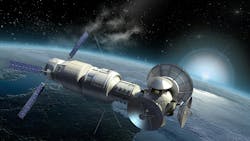NASA looks to industry and acadamia to investigate V-Band relay networks to transmit large volumes of data with low latency
CLEVELAND - The National Aeronautics and Space Administration's (NASA) John H. Glenn Research Center (GRC) in Cleveland has developed a comprehensive statement of objectives (SOO) to explore the implementation of V-Band relay networks for the efficient transmission of large volumes of science and Earth remote sensing data.
This initiative primarily targets scientific and Earth remote sensing missions that require rapid data transfer to support essential capabilities such as climate monitoring, resource management, oceanography, and disaster response.
The objective is to establish a high-speed, low-latency communication system through the development and use of V-Band relay networks. These networks will address the burgeoning data volume and the urgency for quick data delivery in scientific and remote sensing missions.
The primary aim is to demonstrate the feasibility and effectiveness of V-Band cross-links in space. The goal is to transmit substantial volumes of science and Earth remote sensing data swiftly and efficiently to end users.
The contractor will design, build, launch, and operate small satellites to demonstrate the V-Band cross-link capability. This includes conducting a series of reviews (Mission Concept Review, Mission Design Review, Characterization and Experiment Plan Review, and Launch and Operational Readiness Review) with NASA subject matter experts to ensure a high probability of success.
The contractor will facilitate academic institutions' participation in the project, allowing them to conduct relevant space-communication experiments. The extent of this collaboration will be defined in the contractor’s characterization and experiment plan.
Overall, this project aims to push the boundaries of satellite communication technology, leveraging V-Band frequencies to meet the increasing data transmission needs of scientific and Earth remote sensing missions. By engaging both industry and academia, NASA seeks to foster innovation and ensure the successful deployment of advanced communication systems.
Prospective offerors are encouraged to notify this office of their intent to submit an offer. All contractual and technical questions must be submitted electronically via email to the Contracting Officer at [email protected] before 21 June 2024 at 12:00 p.m. EDT. Additional information is available at https://sam.gov/opp/896a89e47ec84b25b952673c1142809f/view.
